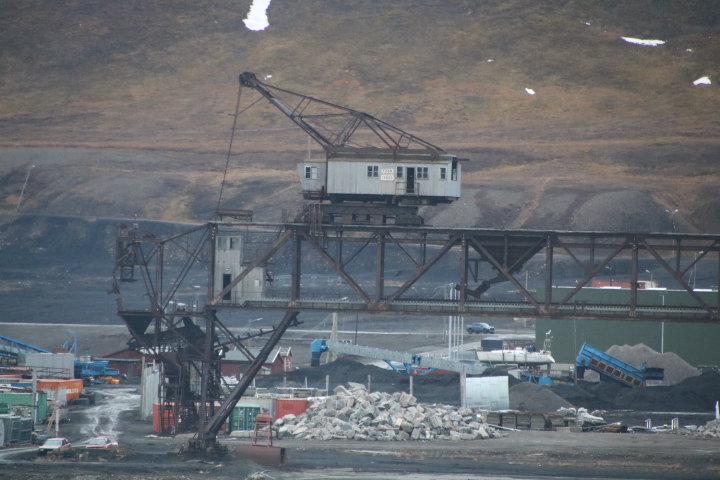We entered the Isfjorden, 78N 13E, at 08:27 with snow down the slopes of the mountains to just short of sea level.




Svalbard (Spitsbergen) is one of Europe’s last wilderness areas (about the size of Scotland) and is the home to more polar bears than people. It is also as close as one can get to the North Pole without walking over the Arctic ice!
The islands are mentioned in Icelandic Sagas of the 12th century, but it was Willem Barents, whilst searching for the northeast passage as a route to China in 1596 did it take the name Spitsbergen. Apparently, this is because of its ‘sharp mountains’. The Norwegian name Svalbard is derived from the Old Norse for ‘cold coast’. Today the name Spitsbergen is the largest island in the group.
The first settlers are likely to have been the Pomors. They were hunters and fishermen from Russia’s north coast and had a long tradition of hunting voyages and it is likely that they found refuge from religious persecution here when their faith was separated from the Orthodox Church in the 17th century. Later whalers from various European countries came to catch whale and walrus.
The first tourists arrived on the islands in the 19th century. A quote in the Spitsbergen Gazette of 1897 relates a traveller’s experience upon seeing the islands for the first time as, “stormy shores, sterile mountains and the nudity of the soil”. This is not surprising as the islands are between 74º – 81º north.
The Treaty of Spitsbergen put the islands into Norwegian territory in order to protect the mineral and natural resources in what was likely to be a ‘free for all’. The whalers were driven by economic forces and any science and understanding of nature was kept to themselves. William Scoresby Jr. in the 17th century did publish his findings and from then on there were explorations conducted to improve the ‘bank of knowledge’ about the natural world.
In the 1920s Svalbard was important for events related to Arctic exploration. Roald Amundsen played an important role in forging the proud sense of Norwegian identity in the early 20th century through his exploits across the world. In 1897 he sailed to Antarctica as First Mate on the Belgica (Belgian) expedition. The ship became trapped in the ice which meant they had to overwinter off the continent and the expedition ended. He was interested in polar regions and set his sights on the Northwest Passage and the significance of the Magnetic North Pole. He left Oslo in 1903 and overwintered off King William Island and by 1905 escaped into the western Arctic Ocean and became, it is thought, to be the first person to navigate the passage. Historians think his next mission was to be the first to reach the North Pole but in 1909 Peary (USA) achieved that goal, so it was to the south he headed, leaving Norway in 1910 and dropped anchor off Antarctica in January 1911 (it is thought a little closer to the continent than Scott). RA reached the South Pole on 14th December 1911 beating Scott by just over one month. In 1926 he left Spitsbergen to fly over the North Pole and 16 hours later dropped Norwegian and US flags at the Pole and continued to a landing in Alaska, a record 72-hour trans-polar flight. In May 1928 he attempted another polar flight on the airship Italia, captained by Umberto Nobile which crashed and his body has never been recovered.
Coal was the most important resource of Svalbard in the late 19th and early 20th centuries when Europe needed fossil fuels. These were found in massive quantities in the carboniferous rocks of the island. The race was on and many companies were formed as in the gold rush of North America to retrieve the coal reserves. There was a problem and that was access at 40-50m above sea level. The extraction was relatively easy but getting the coal to be exported was difficult.



A system of cable-hauled haulage and inclined planes are the northernmost railway systems of the world. Much of the system remains today. The aerial ropeways at Longyearbyen are frozen in time as if they were stopped when the coal measures were last mined in 1998. Some of the rights to mine here were sold to the Sheffield (UK) based ‘Spitsbergen Coal and Trading Company’ in 1904. The company built a small town to accommodate the miners and their families. The mine’s adit was 48m above sea level hence the need for the inclined plane and railway to link the mine with the jetty. The building resembling a giant spider are the remains of the mines cable railway station (Tauben Esentrale) … coal tub centre. The first cable railway here was built in 1917 to transport coal from the mines to the coal quay. It was replaced by lorries in 1987.











The mine was simple as the permafrost alleviated the need for pit props. It was never particularly profitable except in the two World Wars as it was a reliable source of fuel for the ships involved in the Russian convoys. It was therefore heavily defended.
John Munroe Longyear was a mining engineer who saw the future in 1906 of extracting coal and purchased the mining rights. The area was then known as Adventfjorden and the settlement that now takes his name was originally called Advent City. His Arctic Coal Company rivalled the Sheffield Company and claimed more of the land, hence the permanent settlement known as Longyear City now Longyearbyen.